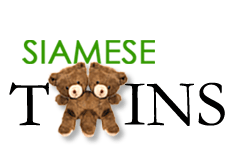 Iran’s Attack on Israel
Iran’s Attack on Israel


5 min read
A case of Siamese twins in England has doctors, judges and moralists perplexed. What does Judaism say about all this?
The situation in Manchester, England is heart-breaking. Two baby girls, barely a month old, are conjoined at the lower abdomen. Mary has no heart or lungs and is being kept alive by her sister Jodie. Jodie has a good chance of survival if separated from her sister. If not, the strain will probably give way to heart failure and kill them both in a few months.
Doctors are ready to perform an operation that would essentially treat Mary as an added appendage – killing her to save Jodie.
The girls' parents, who are devout Roman Catholics, believe that the girls' fates should be decided by God alone. "We believe that nature should take its course. If it's God's will that both our children should not survive, then so be it."
Now, the British High Court and Court of Appeal have both ruled to allow the surgery, and the parents are now considering a further appeal to the House of Lords – the UK's highest court.
In the meantime, time appears to be ticking away for the twin girls.
Rabbi Feinstein Decides
Such complexities are not new to Jewish law.
A case of Siamese twins is mentioned in the Talmud (Menachot 37a), and in recent times, the illustrious American Rabbi Moshe Feinstein used Talmudic sources to present a clear and unambiguous ruling in such a case:
In 1977, new-born Siamese twins were brought to Children's Hospital in Philadelphia, where Dr. C. Everett Koop, who subsequently became Surgeon General of the United States, was then the hospital's Chief of Surgery.
"The ethics are too complex, so I defer to an old rabbi in New York."
Doctors had determined that if the twins – who were sharing critical internal organs – would remain joined together, both would die. The only option was to perform an operation which would kill one and save the other. But, argued the moralists, isn't this murder?
Rabbi Dr. Moshe Tendler records this scene in 1977:
When the team of 20 or so [medical] professionals were awaiting Rabbi Feinstein's decision, and indeed, were expressing impatience at the lapse of time, which interfered with their private, professional lives significantly, Dr. Koop quieted the group with the following statement:
"The ethics and morals involved in this decision are too complex for me. I believe they are too complex for you as well. Therefore I referred it to an old rabbi on the Lower East Side of New York. He is a great scholar, a saintly individual. He knows how to answer such questions. When he tells me, I too will know."
Rabbi Feinstein asked the doctors: "How do you intend to perform the surgery?"
They told him: "We will save Baby-A, and kill Baby-B."
Rabbi Feinstein then asked, "Could you reverse the procedure and achieve the same results? Meaning, could you use all the available organs to save Baby-B and instead kill Baby-A?"
The doctors answered: "No. Baby-A is the only one we can save."
The law of the pursuer applies even in the case where the threat to life is unintentional.
At which point, Rabbi Feinstein told them to go ahead and perform the surgery. His decision was based on the Jewish law which states that if one person is directly threatening to kill another, then it is morally correct to stop the pursuer, even if it means killing him. The law of the pursuer applies even in the case where the threat to life is unintentional. For example, this principle has bearing on the case where a fetus is unwittingly threatening the life of its mother, as discussed in Maimonides - Foundations of Torah 5:5. (Of course, each case is different, and this should not be taken as a definitive practical ruling on Judaism's approach to abortion.)
Applied to the Siamese twins case, Rabbi Feinstein ruled that since Baby-B had no independent ability to survive, the very existence of Baby-B was threatening the life of Baby-A. This gave Baby-B the status of a killer (albeit unintentional), and Baby-A could, so to speak, stop his killer.
The British Courts
While the British Court of Appeal ruled similarly to Rabbi Feinstein's Talmudic logic, the British High Court used a much different line of reasoning.
Judge Robert Johnson said that for Mary – without heart and lungs – her harsh life would only worsen as low levels of oxygen in her blood further destroyed her brain. So killing Mary – by stopping delivery of Jodie's blood – would be an act of euthanasia, like withdrawing food and water from a terminally ill patient. If they stayed together, the few months of Mary's life would be hurtful and mean nothing to her, he said.
They were prepared to let the viable sister die.
The contrast is quite ironic. The ruling of the Talmud is predicated on the preservation of life. Whereas the British court ruling is based on a decision to end a life, that of the non-viable sister. Without that factor, they'd be prepared to let Jodie, the viable sister, die.
The case in England involves other medical and legal factors, and we cannot derive any practical decision based on Rabbi Feinstein's case. But this story does illustrate how in a world full of ethical issues like cloning, euthanasia and the homeless, the truth of Torah can increasingly serve as a "Light Unto the Nations" (Isaiah 42:6).
We pray for the health of the little girls, and for all parties involved to act with wisdom.
